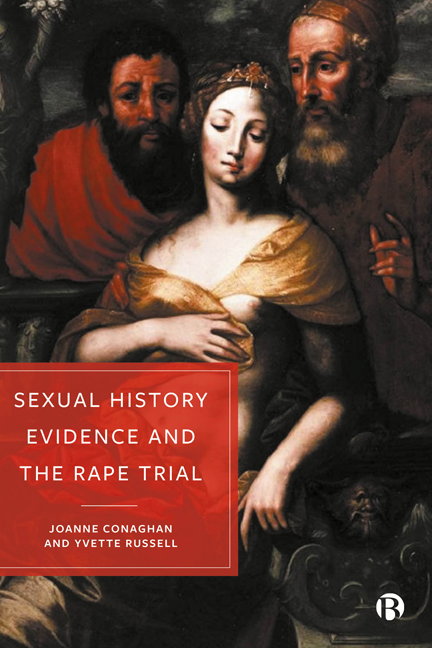Book contents
- Frontmatter
- Contents
- List of Cases
- List of Statutes
- About the Authors
- Acknowledgements
- 1 Introduction: Setting the Scene
- 2 A History of Rape Law in Action
- 3 Emergence of a Legal Regime Governing the Use of Sexual History Evidence
- 4 Legal Regulation: Limits and Potentialities
- 5 Tracking the Use of Sexual History Evidence in the Courtroom
- 6 The Relevance of Sexual History Evidence
- 7 Sexual History Evidence and Subjectivity
- 8 Conclusion: What Is to Be Done about Sexual History Evidence?
- References
- Index
3 - Emergence of a Legal Regime Governing the Use of Sexual History Evidence
Published online by Cambridge University Press: 03 April 2024
- Frontmatter
- Contents
- List of Cases
- List of Statutes
- About the Authors
- Acknowledgements
- 1 Introduction: Setting the Scene
- 2 A History of Rape Law in Action
- 3 Emergence of a Legal Regime Governing the Use of Sexual History Evidence
- 4 Legal Regulation: Limits and Potentialities
- 5 Tracking the Use of Sexual History Evidence in the Courtroom
- 6 The Relevance of Sexual History Evidence
- 7 Sexual History Evidence and Subjectivity
- 8 Conclusion: What Is to Be Done about Sexual History Evidence?
- References
- Index
Summary
Introduction: Hale’s legacy
Matthew Hale is often maligned for visiting upon women in perpetuity a legal regime ill-disposed towards the rape victim (see, for example, Geis, 1978). In fact, Hale adopted a more liberal approach to rape law than many of his contemporaries. As we saw in Chapter 2, Hale rejected the emission requirement long before it was finally abandoned and was sceptical of the claim that conception evidenced a woman’s consent to sex. True, wives have Hale to thank for crafting the legal rationale supporting the marital rape exemption. Nevertheless, his most lasting contribution to the legal treatment of rape surely arises from his remarks about the need for caution when assessing the credibility of a rape complainant.
Hale did not invent the idea that rape victims should not be trusted. It was not uncommon, even in the 17th century, for men accused of rape to attribute a malign motive to their accuser. Certainly, by the time Hale’s treatise was published in 1736, challenging the motives and veracity of the rape prosecutrix was a recognised defence tactic (Simpson, 1986; Edelstein, 1998). Hale’s comments would have resonated with a legal and popular culture already well attuned to the idea that women lacked moral fibre and were prone to dissemble, particularly about matters of sex (Fletcher, 1995: 69–77). Nevertheless, it would be wrong to view Hale’s remarks solely in terms of the misogynistic attitudes of the time. As Laurie Edelstein acknowledges, Hale was genuinely concerned to ensure that those accused of serious crimes received a fair trial (Edelstein, 1998: 355–6), repeatedly expressing the view that justice should err on the side of the innocent: ‘It is better that five guilty persons should escape unpunished than one innocent person should die’ (Hale, 1800: 39.289).
Yet, such a juristic preoccupation with countering the risks of false accusations of rape does not appear to have extended to other crimes or certainly not to the same extent. Hay’s analysis of malicious prosecution cases in the 18th century shows, rather, a lack of judicial and public concern about false accusations other than of rape (1989: 377–8).
- Type
- Chapter
- Information
- Sexual History Evidence and the Rape Trial , pp. 39 - 65Publisher: Bristol University PressPrint publication year: 2023

